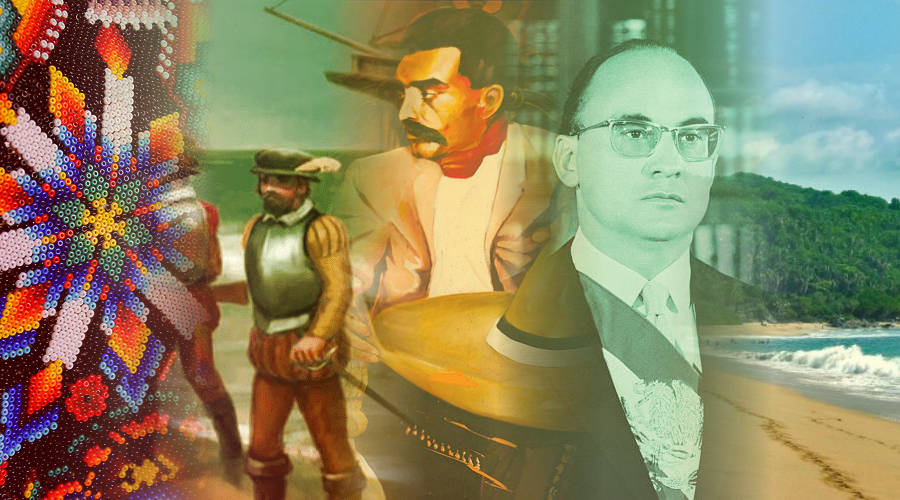San Pancho, Nayarit, Mexico has a rich history that has helped shape the town into the unique community that it is today. In this article, we’ll walk you through the events that have contributed to the present-day community of San Pancho.
Pre-Hispanic Roots in Nayarit and San Pancho
Before the Spanish arrived, San Pancho was home to the native Huichol and Cora tribes. The Huichol are the most well-known tribe here in San Pancho and are known for their colorful art using yarn and beads, which can be seen throughout San Pancho and neighboring towns.
The Cora are known for their agricultural techniques that allowed them to inhabit much of the region. The main crops they harvest are corn, beans, and sugar cane.
These tribes inhabit the Sierra Madre mountain range that stretches from the Gulf of California down through the Western coast of Mexico, including the state of Nayarit and ending at the trans-Mexican volcanic belt.
Spanish Explorers Arrive in San Pancho
The Spanish first arrived in the region in the year 1524 and made contact with the Cora and Huichol tribes. This is also the year that the Spanish military explorer Don Francisco Cortés de Buenaventura arrived at San Pancho. At this time, he named the town San Francisco, in reference to St. Francis of Assisi, the patron saint for animals and nature.
For more than 100 years, Spanish conquistadors would destroy native Cora towns and try to take over the land. In 1722, the tribe leader was captured and the Spanish began establishing missions throughout the Cora territory. The Cora decided to fight and rebel against Spanish control, while the Huichol chose to flee and retreat into the mountains.
Land Reform in Mexico
One important outcome of the many rebellions and uprisings that occurred before and during the Mexican Revolution, was the creation of land reform. In 1914, presidents began focusing on land reform, seizing land from the elite and redistributing it to Mexicans in need. The land that was given back to the communities was referred to as ejidal (community) land. This began the momentum of using land reform as a type of nationalization, where all Mexican citizens have land to work in order to support their families, regardless of economic status. However, over the years, land reform has gone back and forth between giving foreign owners and the wealthy access to more land and protecting the rights of Mexican citizens to own land as a right of citizenship. San Pancho is part of the Sayulita ejido that was formed in 1941. The Sayulita ejido includes Sayulita, San Pancho, Higuera Blanca, and Lo de Marcos.
Luis Echeverría Arrives At San Pancho
The ex-president of Mexico, Luis Echeverría, is considered the founding father of San Pancho because of his dedication to developing the town. San Pancho has always had a certain charm, which is evident by the fact that President Echeverría loved San Pancho so much, that he decided to make it the site of his family’s vacation retreat. While most towns along the coast of the Banderas Bay and the Riviera Nayarit are known as fishing villages, San Pancho has its roots in both ranching and fishing.
While president, Luis Echeverría dedicated his time to developing San Pancho into a model, self-sufficient village that other third-world countries could look to as an example. In fact, his inspiration can still be seen throughout the town. The name of San Pancho’s main street is called Tercer Mundo (Third World) and the names of all other streets are third-world countries and continents.
He funded numerous projects, including:
• Housing for the villagers
• Schools
• A state-of-the-art teaching hospital
• An agriculture university
• A fruit processing factory for local, tropical fruits
• A fish processing center
However, after President Echeverría’s term was completed, he left the country and therefore San Pancho and his estate were abandoned. There was no more funding or support to continue the development of San Pancho: The factory ceased to operate, the University closed, and the town’s inhabitants were forced to leave their jobs at the factories and return to fishing and raising livestock.
Current Growth and Interest in San Pancho and the Banderas Bay Region
In recent years, as popularity in Puerto Vallarta has grown exponentially, more people have grown interested in exploring more quiet, untouched towns to the North.
Fortunately for San Pancho, growth has not matched that of its surrounding neighbors and allows the town to retain its unique qualities as a community. Currently, San Pancho continues to be an example in the region with projects like a non-profit community center, called EntreAmigos, and is also referred to as the Cultural Capital of the Riviera Nayarit.

